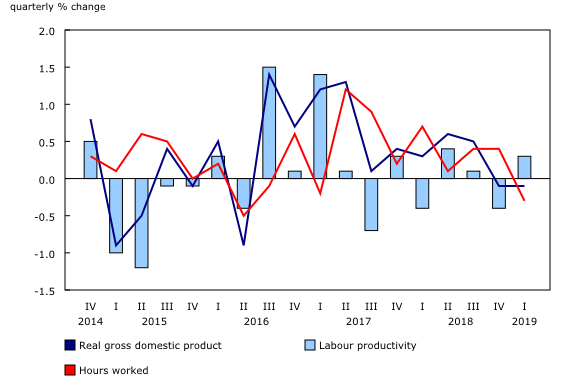Labour productivity, hourly compensation and unit labour cost, first quarter 2019
Archived Content
Information identified as archived is provided for reference, research or recordkeeping purposes. It is not subject to the Government of Canada Web Standards and has not been altered or updated since it was archived. Please "contact us" to request a format other than those available.
Released: 2019-06-05
First quarter 2019
0.3% 
(quarterly change)
Productivity increases after declining in the previous quarter
Labour productivity of Canadian businesses increased 0.3% in the first quarter, following a 0.4% decline in the fourth quarter of 2018.
This slight rebound in productivity primarily reflected the decline in hours worked following seven consecutive quarterly increases, while business output remained virtually unchanged.
Real gross domestic product (GDP) of businesses edged down 0.1% for the second consecutive quarter. In the first quarter of 2019, the decline in the output of goods-producing businesses (-0.6%), particularly mining, quarrying, and oil and gas extraction, more than offset the growth in the output of service-producing businesses (+0.4%).
At the same time, hours worked in the business sector decreased 0.3%, after increasing 0.4% in each of the previous two quarters. This was the first decline in hours worked in two years. Hours worked fell at a similar pace in both goods-producing (-0.3%) and service-producing (-0.4%) businesses. Overall, 11 of the 16 main industry sectors posted decreases in the first quarter. Mining, quarrying, and oil and gas extraction (-1.8%) and administrative services (-1.6%) had the largest decreases, while real estate (+1.0%) reported the highest increase.
The increase in productivity in the first quarter was mainly attributable to service-producing businesses, up 0.7%. Administrative services (+2.0%), other business services (+1.3%), wholesale trade (+1.1%) and professional services (+0.9%) contributed the most to this increase.
Productivity in goods-producing businesses fell 0.3%, mainly as a result of a 2.4% decrease in mining, quarrying, and oil and gas extraction. Decreases were also observed in public services (-0.6%) and agriculture and forestry (-0.3%). On the other hand, productivity was up in manufacturing (+0.7%) in the first quarter, while construction edged up 0.1%.
In the United States, labour productivity of businesses increased 0.9% in the first quarter, following a 0.3% gain in the previous quarter. This growth mainly reflected the gain in real GDP of American businesses (+1.0%), while hours worked edged up 0.1%.
Unit labour costs post another strong increase
Labour costs per unit of output in Canadian businesses rose 1.1% in the first quarter, the same pace as in the previous quarter.
This increase in unit labour costs was explained by faster growth in average compensation per hour worked (+1.4%), while productivity rose 0.3%.
In the first quarter, hourly compensation recorded its strongest growth since the fourth quarter of 2017, rising 1.8% in goods-producing business and 1.1% in service-producing businesses. All the main industry sectors were up, except real estate (-0.4%).
The average value of the Canadian dollar relative to the US dollar declined for the fourth consecutive quarter, decreasing 0.7% in the first quarter. With this depreciation, unit labour costs expressed in US dollars for Canadian businesses rose 0.5%, following zero growth in the previous quarter.
In comparison, unit labour costs of American businesses edged down 0.2% in the first quarter, after increasing 0.6% in the previous quarter.
Sustainable Development Goals
On January 1, 2016, the world officially began implementation of the 2030 Agenda for Sustainable Development—the United Nations' transformative plan of action that addresses urgent global challenges over the next 15 years. The plan is based on 17 specific sustainable development goals.
The release "Labour productivity, hourly compensation and unit labour cost" is an example of how Statistics Canada supports the reporting on the Global Goals for Sustainable Development. This release will be used in helping to measure the following goal:

Note to readers
Revisions
With this release on labour productivity and related measures, data were revised back to the first quarter of 2018 at the aggregate and industry levels. These revisions are consistent with those incorporated in the quarterly gross domestic product (GDP) by income and expenditure and monthly GDP by industry, published on May 31, 2019.
This release also incorporates the new 2018 benchmark data on provincial and territorial labour productivity and related measures, published on May 22, 2019.
Productivity measures
The term productivity in this release refers to labour productivity. For the purposes of this analysis, labour productivity and related variables cover the business sector only.
Labour productivity is a measure of real GDP per hour worked.
Unit labour cost is defined as the cost of workers' wages and benefits per unit of real GDP.
The approach to measuring the real output in the business sector differs from the one that is used in the estimates by industry. For the business sector, output is measured using the expenditure-based GDP approach at market prices. This approach is similar to that used for the quarterly measures of productivity in the United States. However, output by industry is based on the value added at basic prices.
All the growth rates reported in this release are rounded to one decimal place. They are calculated with index numbers rounded to three decimal places, which are now available in data tables.
All necessary basic variables for productivity analyses (such as hours worked, employment, output and compensation) are seasonally adjusted. For information on seasonal adjustment, see Seasonally adjusted data – Frequently asked questions.
Next release
Labour productivity, hourly compensation and unit labour cost data for the second quarter will be released on September 4.
Products
The Latest Developments in the Canadian Economic Accounts (13-605-X) is available.
The User Guide: Canadian System of Macroeconomic Accounts (13-606-G) is available.
The Methodological Guide: Canadian System of Macroeconomic Accounts (13-607-X) is available.
Contact information
For more information, or to enquire about the concepts, methods or data quality of this release, contact us (toll-free 1-800-263-1136; 514-283-8300; STATCAN.infostats-infostats.STATCAN@canada.ca) or Media Relations (613-951-4636; STATCAN.mediahotline-ligneinfomedias.STATCAN@canada.ca).
- Date modified:


